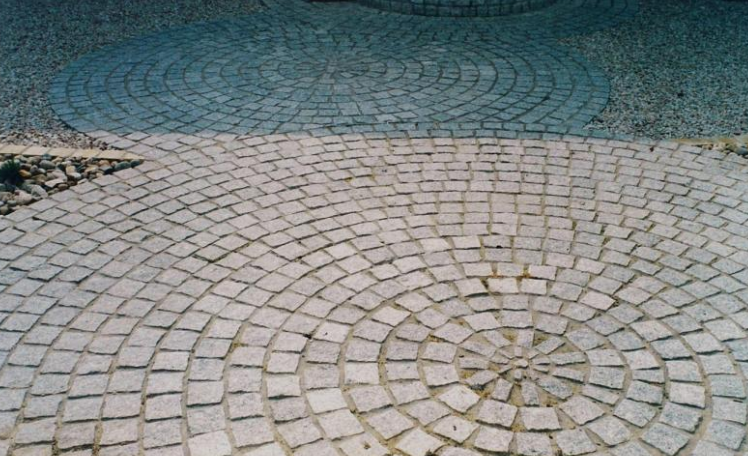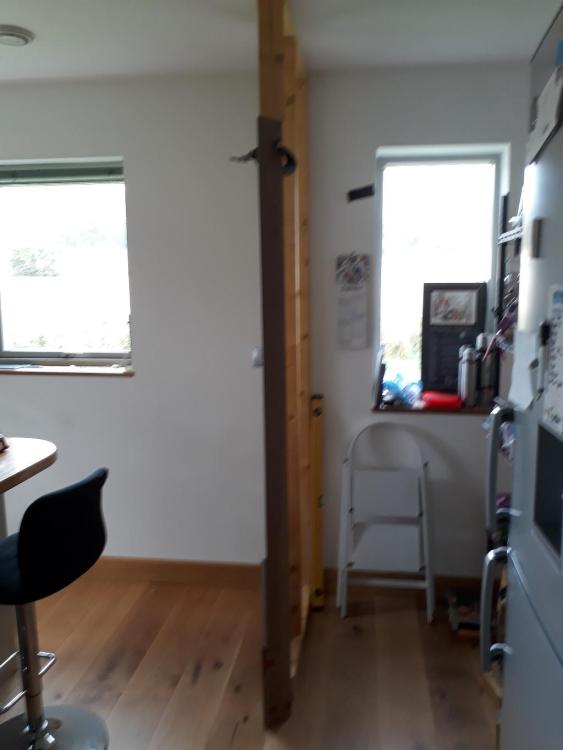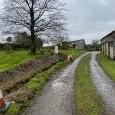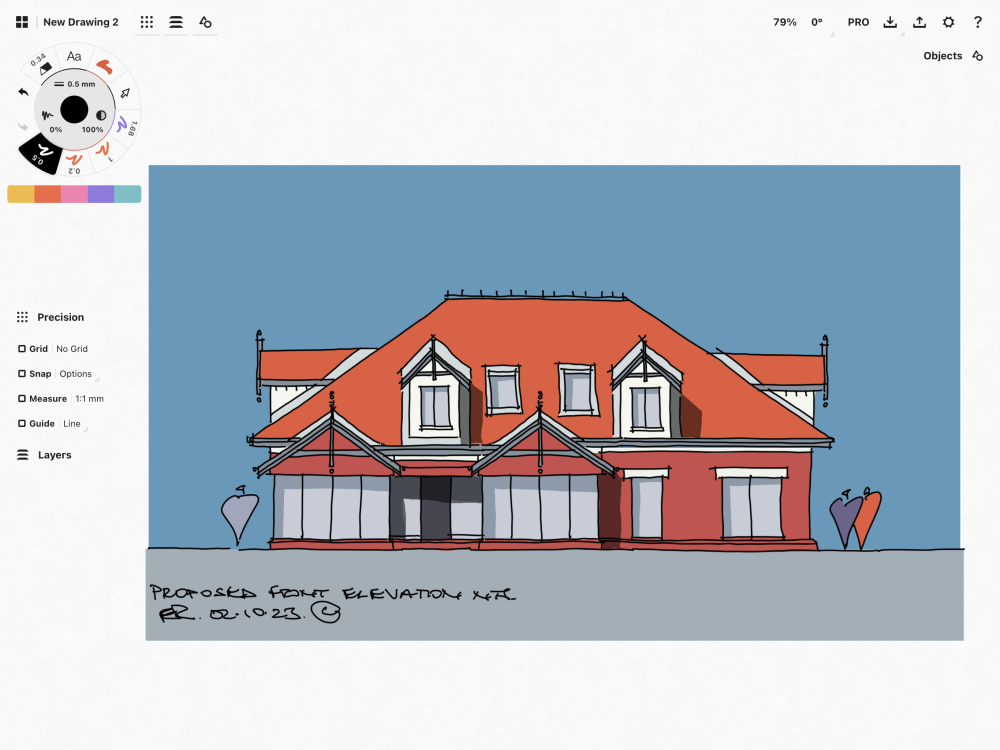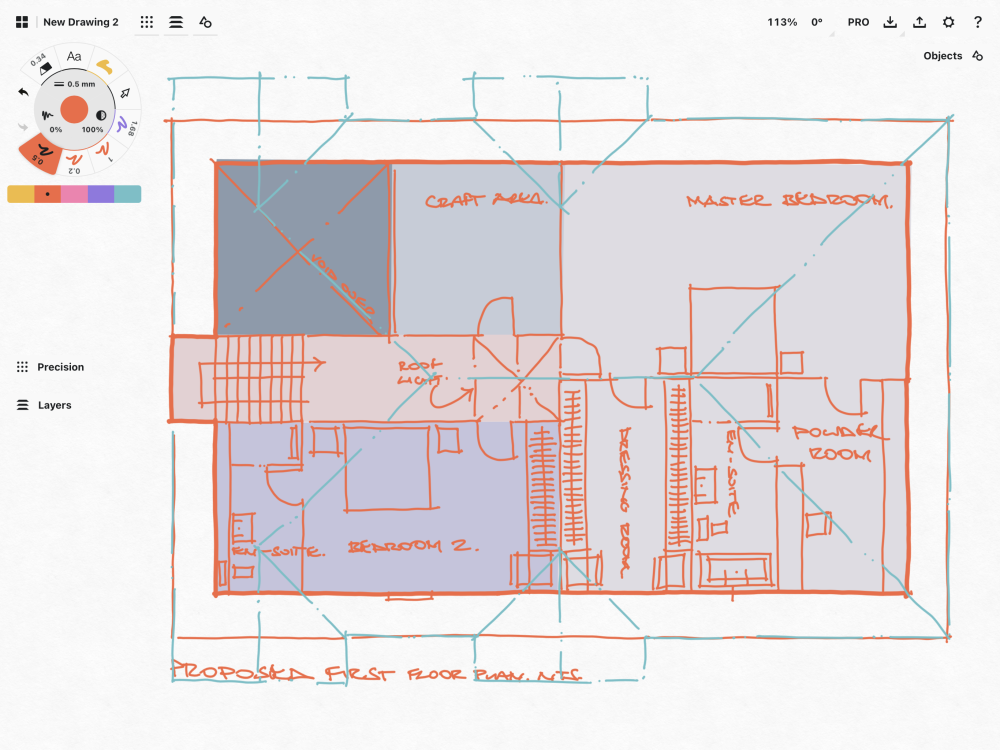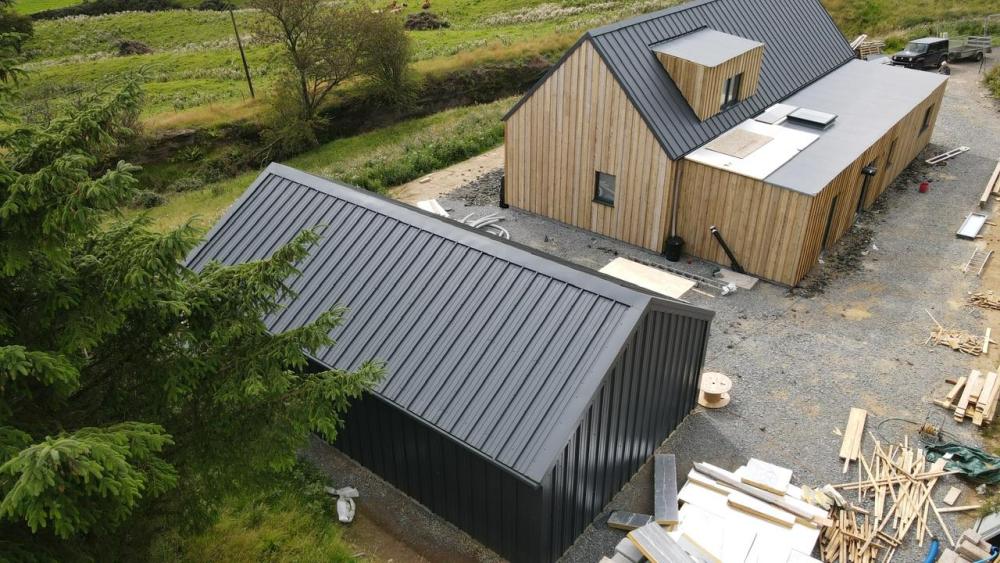Leaderboard
Popular Content
Showing content with the highest reputation on 10/03/23 in all areas
-
2 points
-
Yes, we did it. We built a small, 130m2, to much better than minimum PH standards, house. We heated the whole house to 23C using three electric towel rails, one in each of the bathrooms and 250W electric UFH in the kitchen. We fitted the UFH because there was nowhere to fit a heated towel rail in the kitchen. We installed a Genvex Combi 185LS which provided MVHR, DHW and warm air heating through the MVHR ducting. The warm air heating only came on in the coldest periods. The Genvex unit had a 685W EASHP which heated the integral 185 litre DHW tank to 45C and warmed the air. It worked well but only because the house design was modelled very carefully using the PHPP. Energy usage was very low.2 points
-
Hi all. I don't think this is safe for the following reasons. Mind you you can ask ten SE's and you'll get ten different answers.. here are my thoughts. Agree that the ledger distributes the load over a number of the fixings. Mainly to account for a few badly installed ones. Also agree that if you use EPS or foam 200 you will get initially nominal tension in the anchors (as the say load increases due to snow) as the EPS will compress as the ledger rotates (and the fixings start to bend) due to the added eccentricity of the load. If the ledger was hard against the wall, it was 50 mm thick and with joist hangers then the eccentricity would be would be 50mm, maybe a bit less if the hangers are of wrap over type.. If you put a compressible insulation behind the ledger the eccentricity is now doubled to roughly 100mm and this completely changes the behavoir of the connection in a dramatic way. The insulation is not strong enough to deal with the forces until it compresses by a long way and by that time other things will fail.. probably suddenly which is dangerous. An EPS or Compacfoam 200 insulation means that it will often carry a load of 200 kN/m^2 at 10% compression.. thus before it can carry that much compressive load it needs to compress by 50 x 10% = 5.0mm and by that time your ledger will have rotated a lot and dropped a bit. All the bending forces will by that time get transferred to the fixing which is into brittle masonry. The fixing will now be subject to the same downwards loads (call these vertical shear forces) but also a significant bending force due to the compressible nature of the insulation. This causes the masonry to not least crush as the fixing enters the wall and that can reduce the capacity of the fixing by more than 50%. I have only touched here on some of the basics.. the behavoir of these types of stand off connections is much more complex and you enter into this world at your peril. I think your starting point here is to get a feel for the difference in load capacity of a fixing with a stand off (which is what you have) is to go to the Hilti website and see how much difference it makes when you have a a column base plate set above say a concrete pad stone. You can see this often on lighting standards next to motorways / railways where you can see the column base plates set above the bases with the bolts exposed.. you have something similar. Now even navigating the Hilti or similar site and interpreting the load data is going to take a lot of knowledge, but just have a look.. they have some pretty user friendly diagrams. I hope you'll then see the big load capacity reduction and realise that what you are proposing is not safe unless you design for the completely diiferent behavoir. However there is often more to this than meets the eye. When we design a building we want to tie different bits together for overall stability. In your case this could mean that we want to tie the rafters back to other parts of the house so the whole thing acts as a oner rather than individual elements.. we call this as SE's not least robustness (if one bit fails the rest hangs in there) and look at alternative load paths. We think.. just say the builder cocks that bit up.. is there another way the building can hang in there before it falls down? So rather than pushing the connections to the limit we need to introduce a bit of redundancy to account for human and material error. In principle you could make you thermal break using say something like this https://www.armatherm.co.uk/thermal-break-materials/armatherm-frr/.. I think it is a waste of money.. just accept you have a bit of a cold bridge and beef up insulation elsewhere to compensate. Also remember that you are fixing into old masonry, maybe bricks with holes in them, for the fixings to work well they need to be away from the mortar beds etc.. you are asking too much here.. in theory it may work but can you build it in real life and make it safe? So to conclude my thoughts are DON'T do this. Fit the ledger against the wall, maybe with a DPC behind.1 point
-
What are you doing with this floor? If you are about to properly insulate it and replace it, then you are probably not wanting to ever take the floor up again, so for the cost of some new cable, it would be madness to leave old cable in place, even if it looks okay.1 point
-
I think his agent or architect or whoever drew the plans needs to read the approved documents in relation to fire safety. Three storey will require a protected stairway or alternative means of escape plus having a staircase discharging into the kitchen is as other posters have said not a good idea - perhaps bordering on dangerous. I suspect a fire engineered approach would be required. On a different note if the I can can see the existing floor plans below the proposed floor plans I would suggest demolition and a complete rebuild. To make that many changes is a waste of time.1 point
-
The block manufacturers (marshalls) do rounded features. But whether you can buy a small number I don't know. Ask at the local BM.1 point
-
1 point
-
1 point
-
Slow progress. The first of the 2 stud walls built with my unusual angled corner posts. I can't make the door opening and therefore build the second wall until I know the size of the door. It is stated as 762mm wide, but one review says it is only 750mm wide. It does not actually matter which, but it is no good building a 762mm wide gap to then find the door is only 750mm wide. So the door arrived today. Well I now know the door is in fact about 752mm wide. The bad news is door No 1 arrived damaged. I have reported the damage to the supplier and door No 2 is now on it's way. More waiting around. Good job I am not in a hurry.1 point
-
@Crofter - I did a couple of years in renewables (a franchise business) several years ago (maybe too soon) and something I may go back to once my current job comes to an end. I had no prior experience, but did a HP course, an UFH course, a heat calc course, unvented hot water system course. Was doing alright until the franchisor pulled the plug on us all 😞 Go for it.1 point
-
Hi, some people cut them, others leave then whole and have tapered gaps. What they sit on depends wether you will be running over them or not. But as you mention flower beds then a bit of concrete underneath and haunches at the back to prevent spreading .. again all very easy to see on YouTube1 point
-
I would also add, that you should make it clear to your local planners that you believe your new garage will be a better replacement to the old one, and if it is refused by them you WILL appeal.1 point
-
Then let them refuse it and appeal. My first house I wanted to build a garage (there was none) The planners wanted me to stick it tucked away behind the house taking up the best bit of the back garden, I wanted it alongside the house on a corner plot. Planners refused it, I appealed and won the appeal and the inspectors report praised the siting of the garage.1 point
-
Or you're just paying for labour with materials supplied by you.1 point
-
Be worth popping outside during a downpour & checking that nothing’s overflowing from that gutter. If that’s blocked & sending additional rainwater down to splash up,that will exacerbate the problem.1 point
-
We saw a system at a show called Unico which 'does it all', this is a hot air system, HID loved it and wanted to install. We rejected because I'm very sensitive to air flow and couldn't face the thought of it coming in the room. But, it did look quite good. This was at the Swindon House Building show.1 point
-
We are in a similar position also ICF hopefully very good airtight, (no foundations yet) we are doing a lot our selves so plan to lay UFH pipes and see how warm it feels, then decide on installing the manifold. We will probably be a few years until finished so have plenty time to make changes if necessary. Have you heard of a Willis heater it’s a bit like the internal element of a hot water cylinder plumbed into the UFH system. It could do a whole house or a few rooms. Zoneing or not zoneing the UFH is a decision to read up about. Any solar and batteries being considered? Even in winter we get some sun and together with off peak charging taking the chill of the floor may be all you need to ‘feel’ warm. Any other heating e.g. wood burner, stove.1 point
-
About two times a year, you can get unpredictable levels of sludge, and/or in some drain-fields you can also get reduced drainage, I usually find its between winter into spring and summer into autumn. I have no idea why, but on a number of jobs I have seen this/heard it from customers. Not when I have been involved in the drainage, but as a comment from a customer, or an observation when working there. Usually short lived but I always had it down to bacteria reacting to ground temperature changes.1 point
-
1 point
-
It's probably cheaper to just buy everyone who lives in the property noise cancelling headphones though1 point
-
Beware if there is a chance of the walls being tested. It only occurred once for me because there was a certification needed for use. It failed my target but fortunately was ok because i had overestimated the requirement. The testing expert said that we cannot rely on the lab published test results because they are for optimum conditions, and a sample panel not a real wall.1 point
-
1 point
-
1 point
-
1 point
-
I've deployed a load of pi3 at work running my PHP/mysql data input system on chromium to feed our ERP and production planning system. I think this PI 5 might just be overkill! Good to see the price is still attainable and hopefully they have a good production run so plenty of stock available.1 point
-
Oh yes, wait for @SimonD. When you were running on pump speed1 (6M) the boiler, just before cycling, had flow/return temps of 69/44, a dT of 25C, that boiler apparently has a minimum output of ~ 6.5kw so, by calculation, the flowrate is only, 6.5*860/60/25, 3.73LPM, which, with all those rads just doesn't add up except some big restriction somewhere, you then increased the pump head to 8M and no more cycling, the flowrate should have increased by just over 15% due to the increased head so it still looks as if the heat demand is quite low, maybe, when you get the opportunity, start with d.0 at 7kw, the boiler flow temp should then surely start falling and just increase d.0 (1kw steps) until the flow temp increases to its target temp of ~ 70C, this will then tell the flowrate almost exactly. (by calculation)1 point
-
You could run on CH only, as above, pump on speed 3 (8M) and when the temperatures steady out just close the manual by pass and see what effect this has on the temperatures, particularly, the return. If the boiler remains running just keep reducing d.0? output in say 0.5kw steps until the boiler flow temperature just starts to fall, its quite easy then to calculate the actual system flowrate.1 point
-
I’m not a massive fan of dormers either and have ended up with one as it was the only way to get a big enough bathroom to accommodate a bath and shower while keeping the upstairs floor layout the way we wanted it. In hindsight I would have removed it completely and just made the upstairs layout work but was overruled. That said, it’s detailed well I think and is a nice contrast of shapes and colours. However as Gus says planning did hint about massing when I briefly spoke with them early on about no dormer especially given the big garage roof. There are loads of dormers a bit like this in rural Scotland so it’s a common look. The flat roof still needs to be finished.1 point
-
The boiler isn't the issue really, to a short cycling issue it's how you split the system up. A boiler can only deliver a set min load. If the system isn't big enough to absorb the heat the boiler manages this by shutdown. You may have 3 zones, but how many loops on the UFH have room thermostats and actuators and radiator TRV's? All make a system smaller. For every 6kW of heat delivered from a boiler or heat pump you need approx 50L of water engaged to stop short cycling. If you want to operate on small circuits you need a buffer cylinder in the return of the CH circuit1 point
-
We are building a void in our kitchen. Totally bonkers of course but adds some drama to an otehrwise boring space. Some would say its a waste of space that could have been an ensuite or something, but our dining table will sit in the void and we will be spending far more time at the dining table than in an en-suite bathroom. Its only 2m wide so not massive. The top of our void will have a vaulted ceiling with a velux in the roof to bring in some light and to give stack ventilation if the kitchen overheats. So some practicality too. I think building regs require that a void in the kitchen must be seperated by glass from the first floor. Its a fire regs thing that the kitchen is isolated I think. Ours will have a full height fixed glass pane where the void meets the first floor landing. So smells upstairs won't be an issue for us.1 point
-
At last the SE rang back and admitted that it is B785, so a typo all though the document and double checked by a senior. I also questioned having 2 layers of B785 for a single storey residential floor that will only have household furniture on top. He's now checking if that is really necessary. Shows how much we've learnt since we go the drawings 2 years ago when we just took what they said as gospel.0 points
-
Ok, understood, but I guess any temporary heating system I try and install is going to involve several weeks of faffing.0 points



